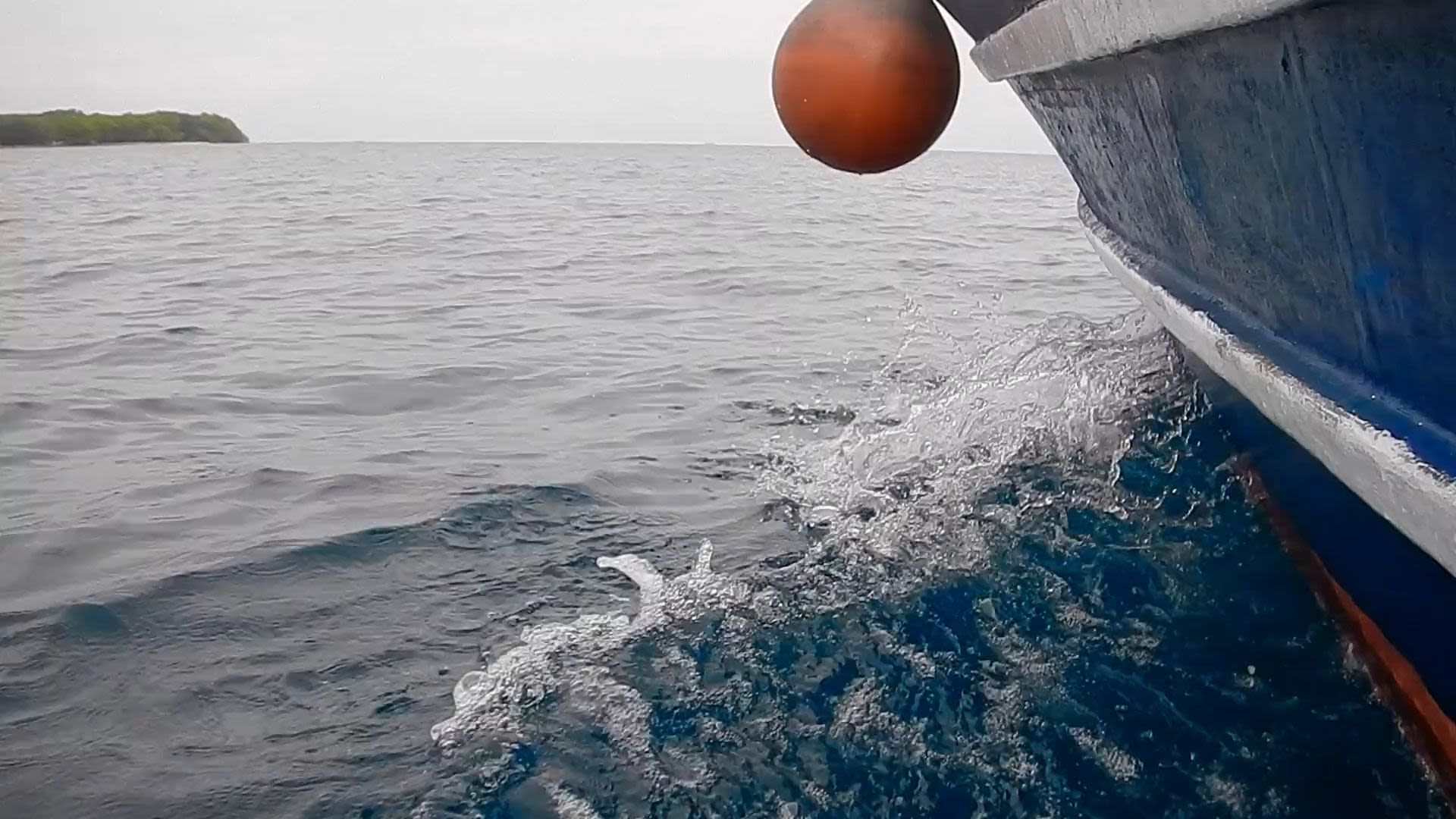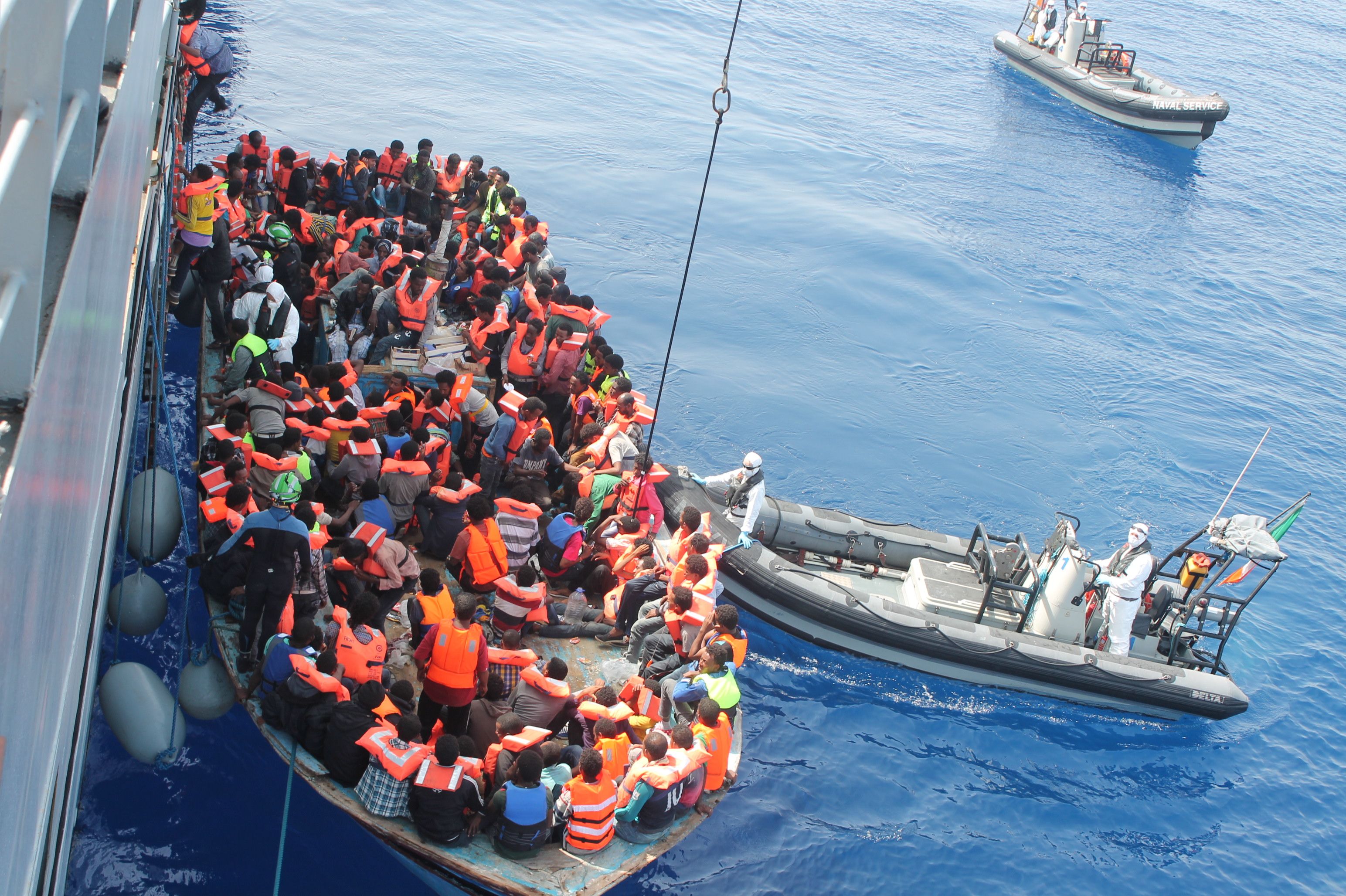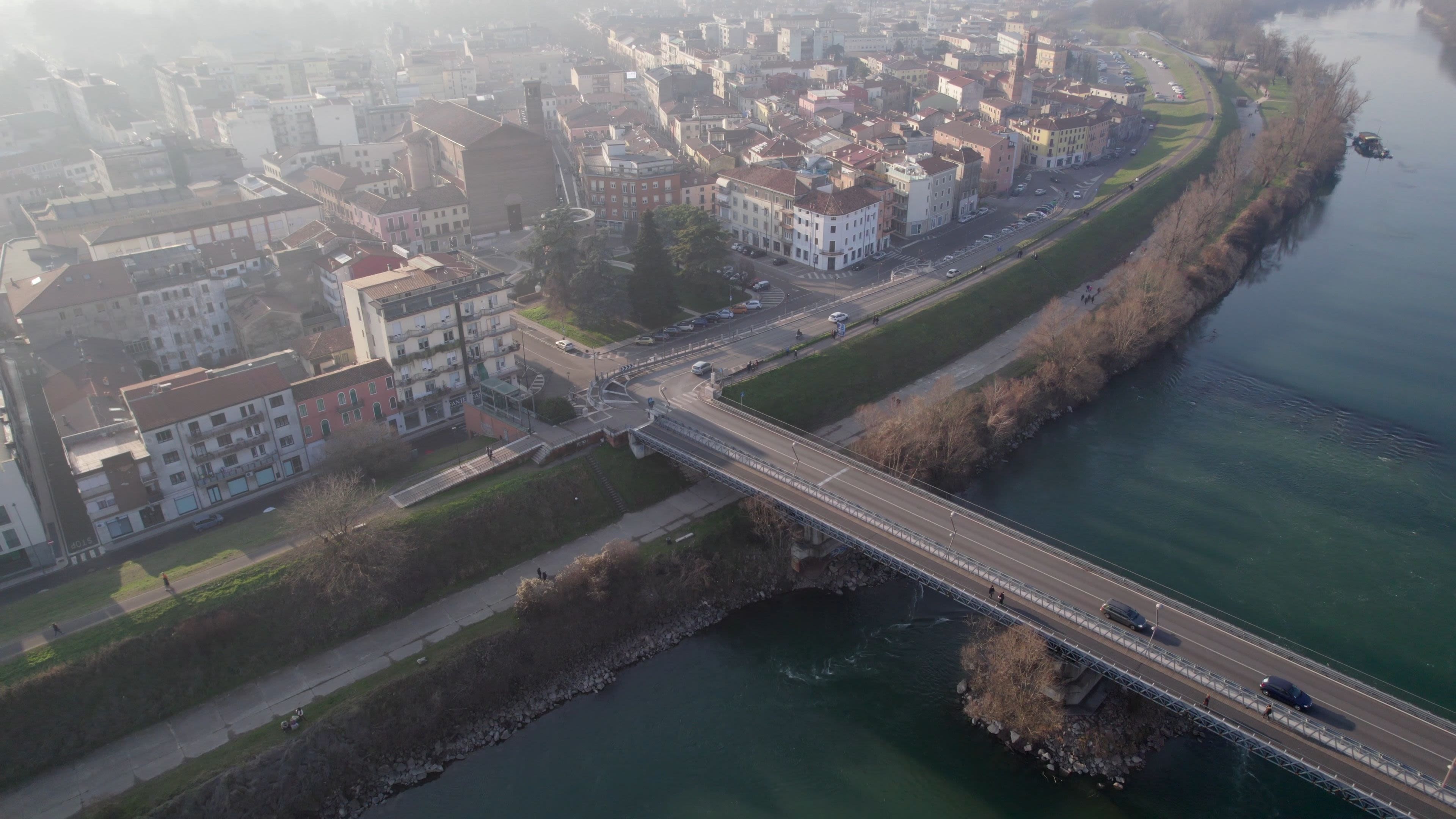LEAVING
AFRICA
Every year, thousands of young men across the continent make perilous, uncertain journeys to faraway countries—putting home, danger and lack of opportunities behind them in hopes of finding a better life. This is Hamsa’s story.
By Fardous Ali

It was barely quiet in Qoryoley, the sound of explosions and passing military vehicles replaced by the early crowing of roosters. This night, however, was different for Hamsa. It was as if the world was giving him a chance to make his escape from a shark’s mouth. A truck was leaving for Ethiopia at 1 a.m., and for Hamsa, being on it was the difference between life and death.
“There is certainly no place like your home,” he says today, requesting anonymity to reflect on the journey on which he left the southeastern town of about 50,000 inhabitants in his homeland of Somalia in the summer of 2014.

Back then, Hamsa was 19 when his life took a turn that he never expected. As the eldest of three children raised by their single mother, he was the backbone of the family. He attended Quranic school, and when his mother remarried, helped his stepfather run the family farm, where they grew vegetables, corn and rice as their main source of income. Even though his immediate daily life was stable, the uncertainty of when and where the next explosion would happen in or near Qoryoley was an ongoing fear.
But there was something he feared even more: the possibility of being coerced to join Al-Shabaab, the al-Qaeda-affiliated insurgent group enmeshed in war-torn Somalia. One day in June 2014, his former teachers from the madrassa, who were also in a network of undercover recruiters who routinely target vulnerable teenage boys and young men to become militia fighters, approached Hamsa. While he knew that accepting their proposal was not a good idea, he also knew that rejecting it would jeopardize his safety and was therefore a worse one.
His main concern became making it to the next sunrise safely. This meant that he didn’t leave his house for days, which turned into weeks and then months. “It became unbearable,” he remembers. “I had to come up with a plan to leave Qoryoley, and my mom suggested that I go to Jijiga,” the capital city of the Somali Region in Ethiopia about 1,100 kilometers north. The plan was set, and in mid-August 2014, he boarded the 1 a.m. transit truck, not knowing that Ethiopia would not be the end of his journey but rather the first stop on it.


A new possibility
After spending a few days in Jijiga, Hamsa met several Somali youths who were planning to immigrate to Europe. He began to think about the possibility of continuing his travel beyond Africa and starting a new life in Europe, where he could find the missing pieces of his life. “I was between making two risky decisions: either going back to Somalia, because Jijiga was a temporary stay, or doing tahreeb to seek something better for my life,” he says.
Tahreeb, an Arabic word that means smuggling, is used in the Somali language to refer to Africans leaving their countries to cross the Mediterranean in hopes of reaching Europe. From 2010 to 2017, 970,000 migrants from sub-Saharan countries arrived in Europe. Beset by internal conflict, Somalia ranks fifth in outmigration among African countries (behind Egypt, Morocco, South Sudan and Sudan), with 2.03 million having left Somalia in 2020 and 28 percent of all African migrants bound for Europe using the Northern Route.
Hamsa chose tahreeb.
He boarded another transit truck from Ethiopia to Sudan with around 50 other young men like him, 21 of them Somalis, all of them seeking better lives for themselves. For most, it was an escape from war and conflict, poverty and unemployment or some combination of these push factors. Across Europe, the pull factor of aging population demographics has necessitated immigration inflows to meet labor demands for decades.
According to the United Nations International Organization for Migration, migrants from the Horn of Africa take one of three routes to Europe, with Italy and Malta as primary destinations; Hamsa traveled the Northern Route through Sudan to Libya used mainly by Somalis, Ethiopians and Djiboutians. In 2018, the IOM reported 32,824 observed movements along the Northern Route and 350,473 migratory movements observed throughout Somalia in various directions.
For three days and two nights, Hamsa ate biscuits and drank water, his nourishment as sparse as the money in his pocket and the extra sweater and phone he carried as his only possessions. His anxiety along the way was palpable, the memory of it still clear today. “I remember so many things going through my head: Will the truck break down because it was carrying more than the maximum number of people? Will we be caught and arrested? Will the people we’ll meet ever understand what we are running away from?” he says. “I was imagining the worst-case scenarios because anything could have gone wrong.”
But luckily, nothing did go wrong. And when he and his fellow travelers reached Sudan safely, Hamsa realized that his real journey was about to begin.
"I was between making two risky decisions: either going back to Somalia, because Jijiga was a temporary stay, or doing tahreeb to seek something better for my life."

Arriving in Sudan’s northwestern desert in September with the sun blazing overhead was dreadful, but the layover before the next leg of the journey to Libya was mercifully brief, barely a 24-hour break for Hamsa and his fellow travelers to prepare themselves physically and mentally for what lay ahead. In the middle of nowhere, all they had to eat were the remains of the snacks they had brought from Ethiopia. At 6 a.m. the next day, Hamsa was awakened by the truck engine turning over, and it was go-time again. The journey was like a chain, and if he missed the truck, then he would be left behind in no man’s land.
“I was hungry, thirsty,” he recalls. “I needed sleep, a restroom, a change of clothes.” But these ordinary physical comforts were the least of his concerns. “I was worried about how and when I would speak with my family. I was worried about how Libya would turn out, because that is every migrant’s nightmare.”
Amina, Hamsa’s mother, was concerned about her son’s safety. “We sent him to Ethiopia to rescue him from the possible threats he could have faced here,” she says, remembering how after speaking to him briefly soon after he left Somalia, she started to worry after not hearing from him again for two weeks. But it would be almost three more months until he was able to call her from Libya.


"I was worried about how Libya would turn out, because that is every immigrant’s nightmare.”

A plea for help
The journey from the Sudanese desert to the Libyan desert took three days. There, three weeks after leaving Somalia and 7,335 kilometers from Qoryoley, he was confronted with the reality of the financial burden of his migration. For the secretive transits that bordered on smuggling operations and the costs of the transportation itself, he owed approximately $3,000 – the 2014 per capita income for Somalia, by contrast, was $374 – and the sooner he could pay that debt, the faster he would be able to leave Libya for Europe, a sea passage of two or three days that would cost another $1,500. “Libya was a hell on Earth,” he recalls. “I don’t think anyone who went there will ever forget what it was like to go through it.”
According to the UN Refugee Agency, Libya is the main departure point for African migrants seeking safety and opportunity. Since the fall of the Gaddafi regime in 2011, with no control over irregular migration flows, Libya has become a major migrant-smuggling hub due to its proximity to Europe, with a complex network of unregulated small- and medium-sized smuggling operations that impose harsh financial terms on migrants seeking to cross the Mediterranean.
It was, in essence, a moment of reckoning for Hamsa, every bit as fraught with anxiety – or even more so – than leaving Qoryoley had been. He was facing the biggest financial crisis of his life, and he didn’t know how and when he would be able to pay. With his mother and stepfather’s income limited to their farming, he worried about adding to their burden. But there was no choice. “I had to call them, or else there was no way out for me. The sooner I paid these men, the quicker I would make it out.” Otherwise, he knew, he would be in peril.
In overcrowded transit centers in the middle of the Libyan desert, migrants face a lack of water, poor hygiene and infrequent clothing changes that often lead to head lice. More dangerous, however, is victimization from extreme physical abuse ranging from torture, rape, enslavement and starvation as a result of not making their payments, staying for too long, getting in fights with fellow travelers or sometimes getting beaten randomly by smugglers, according to a 2021 Brookings Institution report. Hamsa recalls feeling fortunate to get one meal a day. “I was bullied a lot, especially by smugglers who were bigger than me,” he remembers. “I was in line getting food, and [a smuggler] randomly hit me with a metal bat. My God, the pain was enormous.” His left arm was broken.
It took a month for his arm to heal, and Hamsa and other victims nursed their injuries without the benefit of doctors or medicine. His fellow Somalis in the center helped him recover with the little resources they had. While his arm healed, he waited for his turn to call his family, with each of the hundreds of migrants given just one three-minute phone call at the transit center.
When Hamsa’s time came, his mother answered. It was impossible to explain in three minutes everything that had happened since he left Ethiopia, so he had to bite the bullet. “I didn’t know where to start,” he says. “I didn’t want to worry her, but I had to be honest so I could leave this hell.”
“I said, ‘Mom, I decided to do tahreeb and I’m stuck in Libya. Please do whatever you can do and just send me the money.’”
His plea hit like a thunderbolt. “That had to be one of the most shocking incidents of my life,” Amina recalls. “No mother wants her son in that situation. The only solution I had was to call relatives abroad and ask for their help.” In addition to raising money from family, Amina and her husband sold a small piece of land they owned outside their farm. After several weeks of bearing the anxiety of being responsible for Hamsa’s survival, they were able to raise the money he needed and send it through an exchange in Sudan, where an underground operation transferred it to smugglers in Libya.
Setting sail
The process took more than three months, but once his payment was approved, Hamsa felt relief for the first time since leaving home, his freedom a giant step closer. A week later, in January 2015, it was time to cross the Mediterranean. There was no limit to how many people boarded the medium-sized boat, which was jammed with about 230 passengers, Hamsa recalls. In fact, there was no guarantee who would pilot the vessel, with the smugglers asking the migrants who had the most experience driving on water.
“It is often one of the travelers in the group who volunteers to drive the boat, with or without experience, and the rest of them trust their lives with him,” Hamsa says, recalling that as they donned orange life jackets, he thought at that moment that there was no guarantee that he and the others were going to make it.


Crossing the Mediterranean to Italy, Hamsa spent two days and two nights on a boat with about 230 other migrants.
Over 2.5 million migrants have crossed the Mediterranean in an unauthorized fashion since 1970, the International Organization for Migration reported in 2017, while the Missing Migrants Project found that from 2014 to August 2022, a total of 24,413 migrants were reported missing in Mediterranean crossings, 4,055 of them in 2015 alone, the year of Hamsa’s passage.
Hamsa spent two days and two nights on the boat, with nothing to eat or drink and no restroom facilities or place to sleep. “It was impossible to fall asleep,” he remembers, “as there were mountains of waves that vigorously moved the boat. But the best thing to do was to pretend to sleep, as closing my eyes helped reduce the anxiety.” The traumas of the journey as a whole, especially that of the Mediterranean crossing, take emotional and psychological tolls alongside the punishing physicality of the experience – tolls that continue to manifest even after the destination is reached.
“PTSD [post-traumatic stress disorder] is faced by many [migrants] after going through such scarring and traumatic conditions,” says Asma Dhamac, a Somali psychologist and therapist. “Eventually, most people learn how to live with it, because it becomes impossible to forget these tragic events that happened in such a short amount of time.” For Hamsa, the burden of the crossing itself was especially heavy. “I knew about many people who lost their lives in the Mediterranean, and I certainly didn’t want that to happen to us,” he says. “It was hard to be optimistic about what was to come when I was between life and death as I sailed in the middle of the sea.”
Lacking basic navigation tools while sailing, Hamsa and his fellow travelers didn’t know which country they would reach, only that the boat was heading for Europe, following the directions given by the smugglers as the migrants departed Libya. Equipped with a whistle they could use as they neared the shore, they blew it when land came into view, and their boat was then escorted to shore by the Italian coastguard and a Navy team.
On Jan. 27, 2015 – nearly five and a half months after he had left Somalia – Hamsa and his fellow migrants made it to Italy.
They were taken to a small temporary camp about five hours away that was already filled with migrants. Despite the crowding, Hamsa luxuriated in the first shower he had taken after so long, a change of clothes, and a meal of a small bowl of rice and water. But after receiving food and shelter for a few days, Hamsa and his group were told that no further accommodations would be offered. Italy was dealing with a migration crisis following a dramatic increase from 4,406 arrivals making 12,121 applications in 2010 to 119,369 arrivals making 130,180 applications in 2017, according to a report by the European Stability Initiative. In 2015, Hamsa was one of 153,842 asylum seekers who arrived in Italy.
Now he and his fellow travelers were on their own.
A new life
“We had the option of going to other European countries, and a handful of us decided to take a train and go to Germany,” Hamsa says. “Every man was on his own at that moment.” Bittersweet farewells were said as they went their separate ways in small groups. Hamsa and several others took a train to Germany to explore the possibility of getting hosted there. Asked on the train for identification by a German officer, they told him they were new migrants and then were taken to a transit camp about a three-hour drive from that train station.
Hamsa lived in the camp with hundreds of other migrants, mostly Africans and some Syrians and Afghans, for six months as their applications for asylum were processed. He was released from the camp in August 2015, and with support from the German government made his way to Hamburg, where he received housing, German-language instruction education and a monthly stipend. After two years he received German citizenship in 2017.
Hamsa still lives in Hamburg today, where he works as a courier. “I’ve been very lucky to be accommodated and hosted by this country,” he says. “The most challenging things, even after all these years, are the social life, as Germans are more reserved people, and the language barrier.”
"Every man was on his own at that moment."

For the last eight years, since that fateful night in August 2014 when he boarded the truck to Ethiopia, Hamsa has not returned to Somalia. His family has not visited him in Germany, but he stays in close touch with them via phone conversations every few weeks.
“Today I can confidently say that I found the peace I was looking for,” he says. “I’m very thankful.”
But, he adds, echoing a sentiment about the life he left behind in Africa, “there is certainly no place like your home.”
_______________________
GRAPHICS CREDITS
Sailing blue boat/Tom Fisk, https://www.pexels.com/video/sailing-blue-boat-3491911/
African Union Mission in Somalia team heading to Qoryoley, Somalia/Tobin Jones, https://www.flickr.com/photos/au_unistphotostream/13323684623/
Somali National Army soldiers/Tobin Jones, https://flickr.com/photos/61765479@N08/13345590674
African Union responding to an ambush by Al-Shabaab militants/Tobin Jones, https://flickr.com/photos/61765479@N08/13360303504
GIF of Somali soldiers marching/WeTheHorn, https://tenor.com/view/somali-somalia-sna-army-xooga-gif-19191769
Somali migrants getting off a transit truck/J. George, https://www.flickr.com/photos/eu_echo/8205653192
Drone footage of desert mountain landscape/Ton Souza, https://www.pexels.com/video/drone-footage-of-a-vehicle-driving-on-a-curvy-road-4457805/
Desert landscape/Dmitriy Ganin, https://www.pexels.com/photo/van-on-dusty-road-in-mountainous-valley-7772720/
Desert sunset/Prateek Katyal, https://www.pexels.com/photo/brown-sand-field-under-the-sky-3574655/
Desert landscape/Christian Konopatzki, https://www.pexels.com/photo/sand-dunes-on-a-desert-10913234/
Desert landscape/Adrien Jacta, https://www.pexels.com/video/a-desert-land-with-vehicle-driving-under-blue-sky-4361413/
Desert landscape/Amanda Klamrowski, https://www.pexels.com/photo/aerial-of-road-1662647/
Displaced teenagers in a transit camp/Etienne Laurent, https://www.flickr.com/photos/eu_echo/6879892861
African migrant rescue/https://commons.wikimedia.org/wiki/File:LE_Eithne_Operation_Triton.jpg
Migrant rescue by European Union Naval Force Mediterranean Operation team/EUNAVFOR Med, https://www.flickr.com/photos/eeas-csdp/24899308580
Orange and blue life jackets/Ai Weiwei, https://www.flickr.com/photos/158710843@N02/36968361881
Migrant rescue/https://flickr.com/photos/42787928@N06/18304243493
Migrant rescue/David Jones, https://www.flickr.com/photos/dfmagazine/27656136870
Video of Hamsa’s Mediterranean Sea crossing/Hamsa
Italian flag/Kassandre Pedro, https://www.pexels.com/photo/italian-flag-on-clear-sky-4736435/
German flag/Ingo Joseph, https://www.pexels.com/photo/germany-flag-in-front-of-building-109629/
Ariel shot of buildings in Italy/Marian Croitoru, https://www.pexels.com/video/city-buildings-in-drone-footage-11430218/